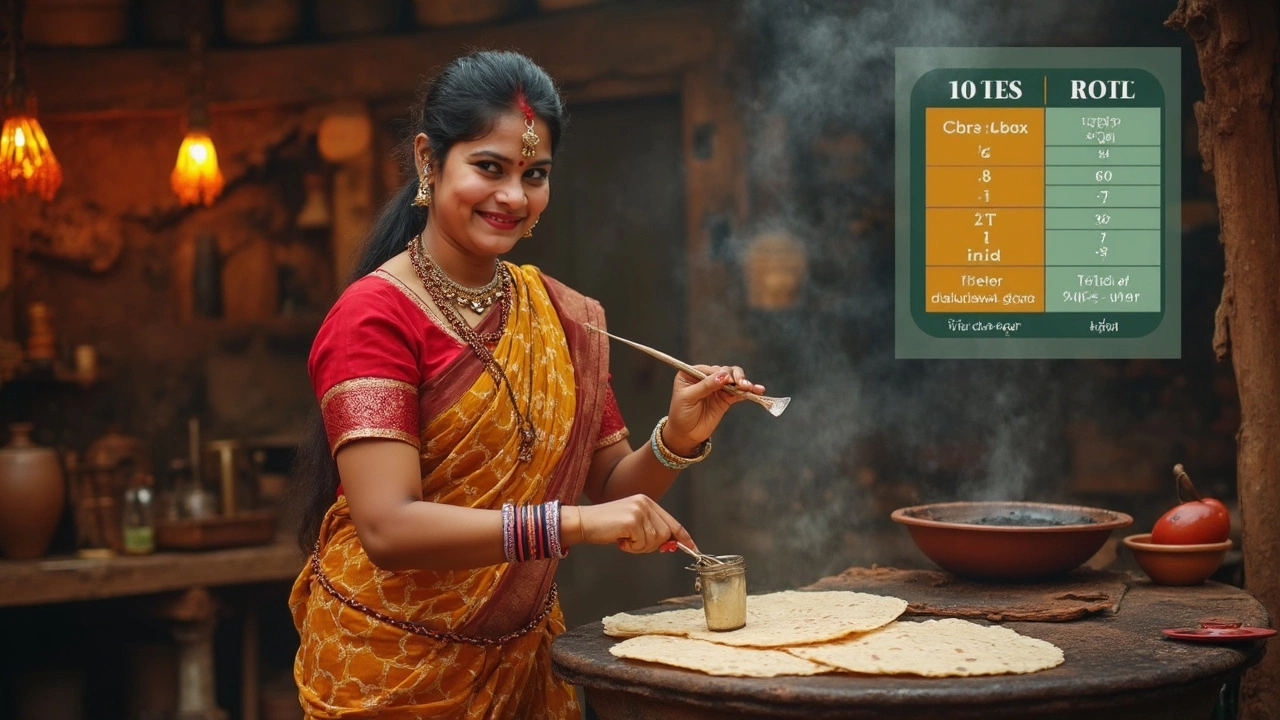Roti Calories Calculator: Know Your Nutrition in Seconds
 Mar, 4 2025
Mar, 4 2025
Ever wondered how many calories you're munching on in that warm, fluffy roti? Tracking your nutrition is simpler than you think with a Roti Calories Calculator. It lets you know exactly what you're consuming, ensuring that you stay on top of your daily intake.
If you're thinking, 'How does this even work?', it's pretty straightforward. One roti usually packs about 70-120 calories depending on its size and ingredients. So, the next time you're planning to indulge, just punch in the details into a calorie calculator to keep track. It's a game-changer, especially when you want to maintain or lose weight.
But why stop there? Knowing how many chapatis you should eat in a day is crucial, especially if you're keeping an eye on your Body Mass Index (BMI). By understanding your BMI, you can tailor your chapati intake to fit your personal health goals. Staying informed about these basics could be a step towards a healthier lifestyle.
- Understanding Roti Calories
- Using a Calorie Calculator
- Legal Aspects of Nutrition
- Local Tips and Insights
Understanding Roti Calories
When it comes to tracking your nutrition, knowing the calories in one roti is super handy. A standard roti or chapati, which is a staple in several South Asian countries, usually consists of whole wheat flour, water, and sometimes salt. It's a humble flatbread, yet it provides a decent energy boost.
Breaking Down the Calorie Count
On average, a medium-sized roti has around 70-120 calories. This variation depends mostly on the size and the type of flour used. For instance, a whole wheat roti is generally heavier and more nutritious compared to one made from refined flour.
| Type of Roti | Calories |
|---|---|
| Whole Wheat Roti | 80-110 |
| Refined Flour Roti | 100-120 |
Why Roti Calories Matter
Understanding these calories is key to meal planning, especially if you’re trying to manage your weight. It helps in determining how many Chapatis Should You Eat in a Day to align with your health goals. Keep in mind your Body Mass Index (BMI) when deciding your daily intake.
Legal and Local Considerations
Did you know that local regulations may require labeling of nutritional information? Check how this applies in your region. In some places, restaurants are mandated to provide calorie counts, which can aid you in making informed decisions.
In areas like India and Pakistan, roti is a daily must-have. Using a calorie calculator can help locals fine-tune their diet without giving up this essential part of their meals.
Using a Calorie Calculator
So, how do you make the most out of a calorie calculator? It's easier than you might think. This tool is like having a nutritionist right in your pocket. Here's how to use it effectively and stay on track with your goals.
Step-by-Step Guide to Calculate Roti Calories
- Find a reliable online calorie calculator. There are many options out there, so choose one with great reviews or recommendations from nutritionists.
- Gather details about your roti: size, ingredients, and any ghee or butter you've added. This info ensures you're getting accurate results.
- Enter the information into the calculator. It will quickly crunch the numbers and tell you the calories in one roti.
- Use the results to adjust your daily diet. Remember, this is just a guide to balance your intake with your activity level and health goals.
Legal Aspects Related to Calorie Calculators
Now, you might not think legal stuff has much to do with calculating calories, but it's essential to be aware. Ensure the calculator or app you're using follows privacy laws and doesn't misuse your personal data. The EU General Data Protection Regulation (GDPR) and similar laws in other regions ensure your data is handled responsibly.
Be cautious of calculators that ask for too much personal information. Stick to tools that require just the basics to get your calorie count.
Local Considerations and Tips
Living in India? You know roti is a staple, and different regions might have variations. Local factors like the type of flour used (atta vs. maida) can affect calorie content. Consider these when calculating your BMI and daily intake.
For those trying to balance tradition with a healthy lifestyle, this tool can be a game-changer in planning meals while still enjoying your local cuisine. And there’s nothing better than knowing you can have your daily chapati and eat it too!

Legal Aspects of Nutrition
When it comes to nutrition, the legal aspects are often overlooked, yet they play a crucial role in ensuring the safety and accuracy of information provided to consumers. Let’s break it down in a way that’s easy to digest.
Food Labeling and Claims
In many countries, including India, food labeling laws make sure that the nutritional information provided on packaged goods is truthful and not misleading. This includes the calories in one roti, which would be crucial for those making informed dietary choices and tracking their calorie intake efficiently using a calorie calculator.
Food labels often list the number of servings in a package, the calorie content, and other macronutrients. This is where understanding calories becomes essential, ensuring you’re not overshooting your daily intake unknowingly.
Regulations for Health Claims
While claims like “low in calories” or “heart-friendly” sound great, legality comes into play to make sure these statements hold up. In some regions, food producers must get approval before they can use specific health claims. This is particularly important for individuals relying on tools like BMI calculations to guide their food choices.
Local Insight on Chapati and Roti
In the Indian context, chapatis are a staple, and the Food Safety and Standards Authority of India (FSSAI) sets forth guidelines for hygiene and nutritional content. Knowing this ensures that consumers are protected and can confidently use roti calories to calculate their dietary needs, matching them with their Body Mass Index (BMI).
| Nutrient | Per 100g |
|---|---|
| Calories | 297 |
| Proteins | 11.25g |
| Carbs | 56.0g |
| Fats | 1.2g |
Understanding the legal aspects helps you make better food choices. Whenever you browse your next chapati, use this handy info to navigate your way through food labels and claims confidently!
Local Tips and Insights
Living in India, chapatis are as staple as it gets. They're not just about satisfying hunger but also about culture and tradition. Let's dive into some local insights and practical tips to keep your nutrition game strong.
Choosing the Right Flour
It's amazing how much variety exists when it comes to the type of flour you choose. Locally, atta or whole wheat flour is popular, offering a good balance of carbohydrates and fiber. Many nutritionists recommend mixing in some besan (gram flour) to make your rotis even more nutritious by adding protein and reducing the calories in one roti.
"Switching up the flour by adding gram flour or millet can make your chapati meals healthier and reduce the glycemic index." — Dr. Neeta Sharma, Nutritionist
Portion Control Tips
Local diet guidelines often suggest that for an average adult, consuming about 3-4 chapatis per day is balanced, especially if combined with vegetables and pulses. But remember, moderation is key! Make sure your meals align with your personal dietary needs and Body Mass Index (BMI).
Using a calorie calculator
Finding a good calorie calculator can save you time. It offers specific insights based on local food preparation methods. Input your roti details - size, type of flour, and cooking style, and the calculator does the rest. You can easily download many options available as smartphone apps catered specifically for Indian dietary needs.
Legal Considerations
In India, paying attention to nutrition information isn’t just a health trend; it’s grounded in legal practices. The Food Safety and Standards Authority of India (FSSAI) mandates precise food labeling, a move that helps you make informed choices.
- Always check for FSSAI certification on packaged flour products.
- Be careful of misleading labels – the term "multi-grain" does not always mean healthy.
Leveraging these local insights alongside a calorie calculator is a smart approach to ensuring your chapati meals are nutritious. Happy eating!